A young lady from Chengdu, only 30 years old, 10 years ago was in debt millions due to online loans and stock trading, but now she can drive a Faraday with one hand, earning seven figures a month and eight figures a year. She is also a long-time friend of mine in the crypto space. Recently, we talked about her glorious history; she spent 3 years in the crypto market learning and practicing. She said making money is too easy, and many people think too complicated. Mastering a set of indicators and reading charts to trade, she only trades when she sees a pattern, and her win rate is as high as 100%, with a record of never losing.
Through my own practice, I have achieved a winning rate of 100%. I have been organizing this recently and am now sharing it with those destined to learn and master it; it's worth keeping!
Attached is a beautiful photo of a young lady.
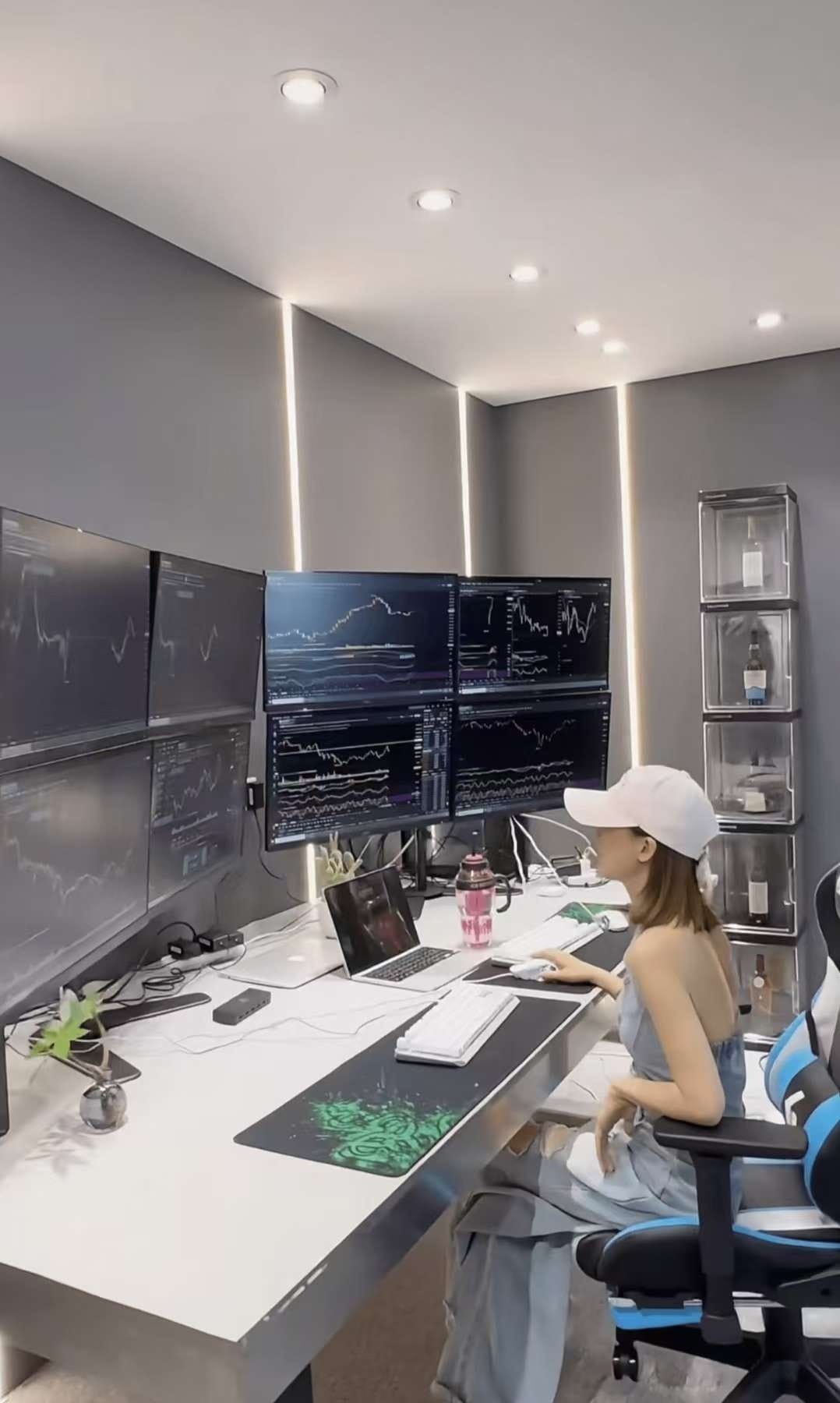
A must-read for those in debt in the crypto space: from online loan liquidation to stable profitability, relying on small trades for consistent profits.
In the crypto space over the past few years, I've seen too many heart-wrenching tragedies: college students taking 100x leverage on online loans, receiving liquidation calls at their counselors; delivery guys mortgaging their only homes to add margin, almost selling their electric bikes; mothers maxing out three credit cards to hold positions, borrowing money for baby formula...
In fact, debt is not scary; what’s scary is trying to fill the hole with a gambler's mentality— the more desperate you are to make up for losses, the easier it is to fall into a deeper pit. Today, I want to share my experience from the past few years teaching people how to clear their debts. Trading contracts is inherently high-risk; if you can't handle it, it's better to live a normal life; daily necessities can also be enjoyable.
Step 1: Cut off the 'toxic sources of capital', don't let debt snowball.
The root cause of debt is often not the loss of money but the vicious cycle of 'robbing Peter to pay Paul'. I’ve seen a brother start with a loss of 50,000, borrowing money to make up for it, only to lose more and end up with a debt of 300,000. The first step to clearing debt is to cut off the source of borrowing.
Immediately stop using all borrowing tools: freeze all credit cards, online loans, and reduce limits to the minimum. Don’t believe that 'using new debt to pay off old debt will help you recover'; operations under pressure will certainly deform—you will be forced to make large bets out of fear of overdue payments, and in desperation to repay, you may hold onto losing trades endlessly, eventually losing control.
Last year, I took a single mother under my wing; she initially used her credit card to add margin secretly, but after I discovered it, I forced her to stop. She said, 'The moment I turned off online loans, although the pressure was huge, I felt more at ease, not needing to calculate interest every day.' Later, she gradually cleared her debts through stable operations and realized: not borrowing means at least not losing more.
Step 2: Establish a 'safe position' to protect the capital.
No matter how much capital you have left, even if it’s only 2000 USDT, you must split your capital according to this ratio; this is the bottom line for survival.
20% USDT-based contracts: only open 1-3x leverage (absolutely do not touch 5x or higher), and each position should not exceed 30% of this portion of funds. For example, with a principal of 2000 USDT, the contract capital is 400 USDT, the maximum position per trade is 120 USDT, and even if it results in liquidation, the loss is only 120 USDT, which does not harm the foundation.
50% spot: Prioritize buying mainstream coins like BTC and ETH; avoid altcoins. If spot drops, there’s a chance to recover, but if altcoins drop, they may truly go to zero. Last year in the bear market, a brother bought BTC with 50% of his position; although it dropped 30%, it rebounded this year, not only recovering but also earning 20%.
30% Stablecoin Wealth Management: Invest in decentralized financial platforms (like those offering 5%-8% annual returns), this portion of money is considered 'emergency funds', and should not be touched unless absolutely necessary. Even earning enough for a cup of milk tea daily is better than losing money.
Remember: During periods of debt, high leverage is poison. 100x leverage looks to make money quickly, but a 1% fluctuation can lead to liquidation, and you cannot withstand the normal volatility of the crypto market.
Step 3: Quick in and out, using 'small steps to win' to smooth out the debt.
Clearing debt is not about getting rich quickly, but about earning small amounts of money every day, accumulating gradually. The 'hotspot quick attack strategy' I summarized is suitable for operations during debt periods.
Only make 1-3 trades a day: focus on 5-15 minute small-scale market movements; do not hold long-term positions. The crypto market has fast fluctuations; small-scale is easier to catch swings and avoids staying up late, which harms health.
Choose the right coin: select mainstream coins with a daily volatility greater than 5% (like BTC, ETH, SOL); coins with low volatility make no money, and those with high volatility are easy to fall into pitfalls. Avoid altcoins that spike suddenly by over 10%; they are likely traps.
Dead stop loss and take profit: set a 1-2% stop loss as soon as you open a position (for example, after buying long, cut immediately if it drops 2%), and a 2-5% take profit (sell half when it rises 3%, keep the other half to watch the trend). Don't be greedy for 'more gains' and don't hope for 'a rebound'; mechanical execution is more important than anything.
Stop trading after daily profits exceed 5%: for example, with 2000 USDT capital, if you earn 100 USDT daily, shut down the computer; don’t think about 'taking advantage of good luck to earn more'. Last year, a mother used this rule to earn 30-50 USDT daily and cleared 380,000 in debt in 6 months.
Deadly taboos: These 4 things will lead to failure in clearing debt.
During debt periods, any mistake can cause you to start over; these 4 red lines must never be crossed.
❌ Prohibit holding a position for more than 4 hours: if a position is losing, accept it; holding a position for more than 4 hours often leads to a collapse in mentality, which usually results in liquidation. I’ve seen a delivery guy hold a position for 3 days, going from a 5% loss to a 50% loss, almost losing his home.
❌ Prohibit trading between 22:00-2:00: This time period is the most volatile in the crypto market and is prone to sudden spikes; staying up late to trade can double the error rate due to lack of clarity.
❌ Prohibit operating more than 2 cryptocurrencies simultaneously: Multi-currency operations can be distracting, leading to neglect of one while focusing on another, resulting in poor execution in all. Focusing on one mainstream coin is 10 times more reliable than messing around with three altcoins.
❌ Prohibit opening positions when emotions run high: after arguments, staying up late, or losing money, do not touch contracts; at this time, 90% of your decisions are wrong. You can set a 'cooling-off period': when feeling bad, force yourself to not operate for 1 hour.
Lastly, I want to say: the most fair thing in the crypto market is 'in front of discipline, all beings are equal.'
I have seen a single mother pay off 380,000 debt in 6 months with 2,000 USD, relying not on luck, but on the daily consistent small profits; I have also seen a rich second-generation spend 1 million capital using 100x leverage to chase altcoins, ultimately turning 911 into Meituan's electric donkey; what was lost was not just money but discipline.
The essence of clearing debt has never been about 'getting rich quickly', but about using mechanical trading to smooth out the debt curve—earning a little every day, not being greedy or gambling, and the debt will slowly decrease like an hourglass. If you are currently trapped in debt, don’t panic; first cut off borrowing, build a safe position, and slowly earn with small orders.
The crypto market has never been just a path for 'gamblers'; by maintaining discipline, even earning 100 USDT daily can lead one out of the abyss. Remember: those who can manage risk are the ones qualified to talk about profits.
Making money in the crypto market does not rely on mysticism; it depends on fully understanding simple techniques and having the determination to follow the rules, allowing for fewer pitfalls and more profits in short-term trading. Follow me for more simple and practical operation techniques, let technology be your source of confidence in making money.
In the crypto market, making one million requires either a big bull market and holding on, or betting on a coin that skyrockets, or using high leverage to bet in the right direction. But most people lose money, so don't just look at wealth stories; first, think clearly about how much risk you can bear.
If you are also a technical enthusiast in the crypto market, click on the coin homepage.
Click on the avatar to follow me for first-hand news and in-depth analysis!
A proven method, turning 500,000 into 10 million using just this one trick (Wolfe Wave trading strategy), with a winning rate as high as 99%, suitable for everyone!
Thinking back to when I first entered the trading market, I tried every means to find knowledge online about this field, hoping to learn everything as early as possible so that I could quickly start practical trading and begin making money.
Now let me bring you some useful insights!
You can achieve significant swings without indicators! The most comprehensive Wolfe Wave trading strategy tutorial on the internet: drawing methods, rules, entry and exit points, stop loss and take profit—all included.

I have mentioned the Wolfe Wave pattern (Wolfe Wave) multiple times in previous articles. It is a powerful chart pattern that often appears near the termination points of price trends. Therefore, it is considered a counter-trend trading strategy. The Wolfe Wave pattern has been proven to be a reliable trading signal worth studying and understanding for technical analysts. This article will focus on the most important features of the Wolfe Wave pattern and some best practices for applying it in the market.
Understanding Wolfe Waves.
Wolfe Waves are a unique pattern that appears in price series. A standard Wolfe Wave structure contains five segments, which exhibit very symmetrical shapes under bullish or bearish market conditions. This pattern most commonly occurs within an ascending or descending trend channel.
Although this pattern can also appear in a fluctuating market, the ideal Wolfe Wave pattern usually shows a certain degree of trend in the price movement. Technical traders can utilize this pattern to grasp entry opportunities more effectively. To accurately identify this structure, some very specific Wolfe Wave rules must be met.
The concept of Wolfe Waves was researched and introduced to the technical analysis trading community by Bill Wolfe. The Wolfe Wave pattern can appear in all time frames of freely traded and liquid financial markets.
Therefore, the Wolfe Wave pattern is considered to have fractal characteristics, appearing on very small time scales, such as one-minute or five-minute charts, as well as on larger time scales, such as weekly or monthly charts.
When traders can correctly identify a Wolfe Wave pattern, they can execute buy or sell setups at high-probability reversal points and can accurately determine the target points for that trade. Therefore, the Wolfe Wave pattern can be an excellent addition to any technical analysis trader's toolkit. Next, we will take a closer look at what a Wolfe Wave pattern looks like.
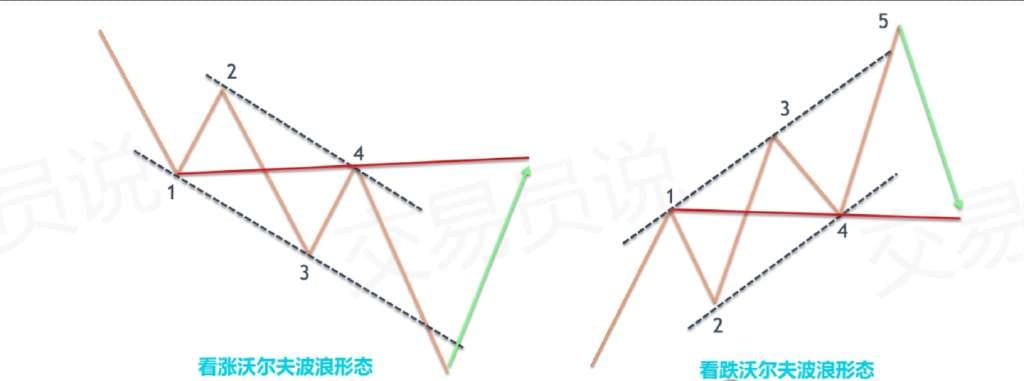
In the image above, the left side shows a bullish (bullish) Wolfe Wave pattern, while the right side shows a bearish (bearish) Wolfe Wave pattern.
⊙ A bullish Wolfe Wave pattern generates a buy signal near the end of the fifth wave, at which point the 1-3 trend line has already been broken downward. After that, the price is expected to rise and encounter resistance near the 1-4 trend line.
⊙ The bearish Wolfe Wave pattern generates a sell signal near the end of the fifth wave, at which point the 1-3 trend line has already been broken upward. Subsequently, the price is expected to decline and find support near the 1-4 trend line.
Bullish Wolfe Wave pattern.
Wolfe Waves usually form within parallel channels or equidistant channels. In other words, the Wolfe Wave pattern will be presented between two relatively parallel trend lines. In the structure of a bearish Wolfe Wave pattern, there will be five price segments, which are roughly equal in length and exhibit symmetry.
In the diagram below, you can see an example of a bullish Wolfe Wave pattern.
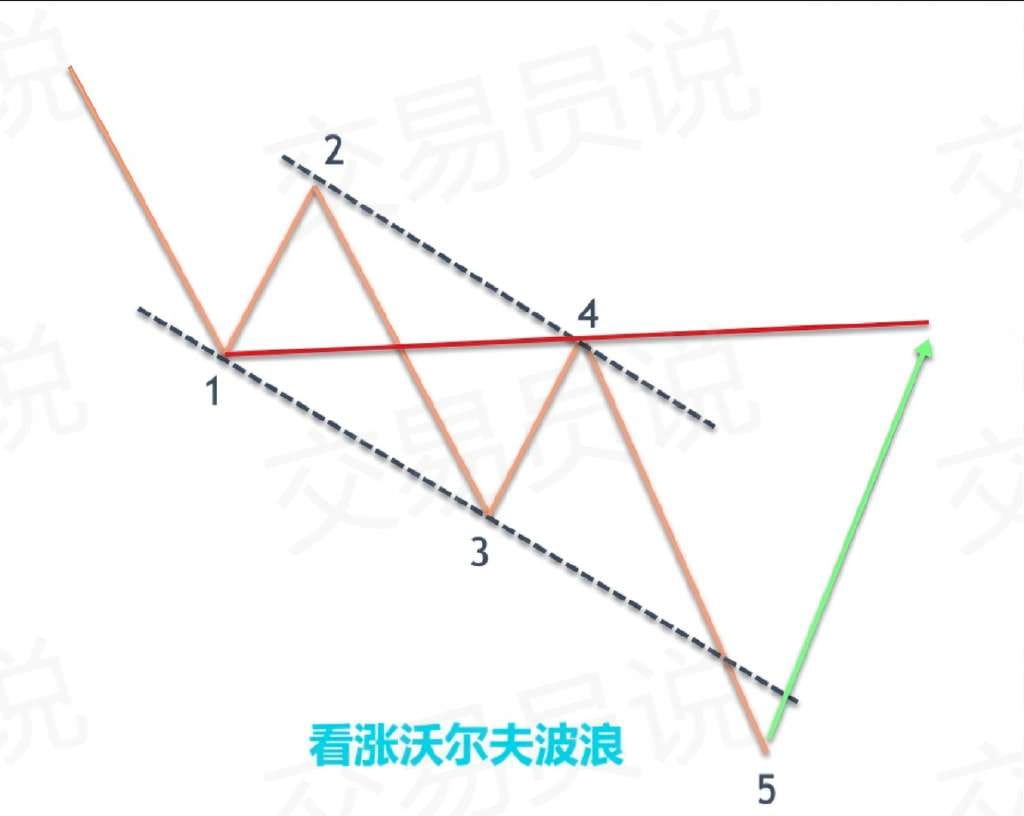
The bullish Wolfe Wave structure begins to decline from the first wave. At some point, the first wave will form a swing low, after which the price begins to rebound upwards in the second wave. After the second wave ends, the third wave starts to decline again, eventually falling below the starting point of the first wave. Then the fourth wave rises, but its peak is lower than the peak of the second wave.
At this point, we need to draw a trend line connecting the end of the first wave and the end of the third wave, referred to as the 1-3 trend line. At the same time, draw another trend line connecting the end of the second wave and the end of the fourth wave, called the 2-4 trend line. We hope to see the 1-3 trend line and the 2-4 trend line appearing roughly parallel.
Finally, the fifth wave should extend downward, breaking below the swing low of the third wave and falling below the lower boundary of the 1-3 trend line.
When the price falls below the 1-3 trend line and is supported in that area, triggering a buy signal, once the price re-enters the channel, we can confidently mark that structure as an effective bullish Wolfe Wave pattern.
The bullish Wolfe Wave pattern is a counter-trend trading strategy. We aim to go long in a generally downward trend to capture an imminent upward reversal. The bullish Wolfe Wave structure provides a target point calculated through the 1-4 trend line. When the price approaches this level, it is expected to meet resistance; thus, this point is also a good opportunity for us to exit long positions.
Bearish Wolfe Wave pattern.
Similar to the bullish Wolfe Wave variant, the bearish Wolfe Wave pattern also appears within parallel channels, where the angle between the rising 1-3 trend line and the rising 2-4 trend line is relatively close. The bearish Wolfe Wave pattern is also composed of five price segments, which are relatively close in length and exhibit a certain degree of symmetry.
Now let’s delve into the details of the bearish Wolfe Wave structure. The diagram below again shows the bearish Wolfe Wave pattern.
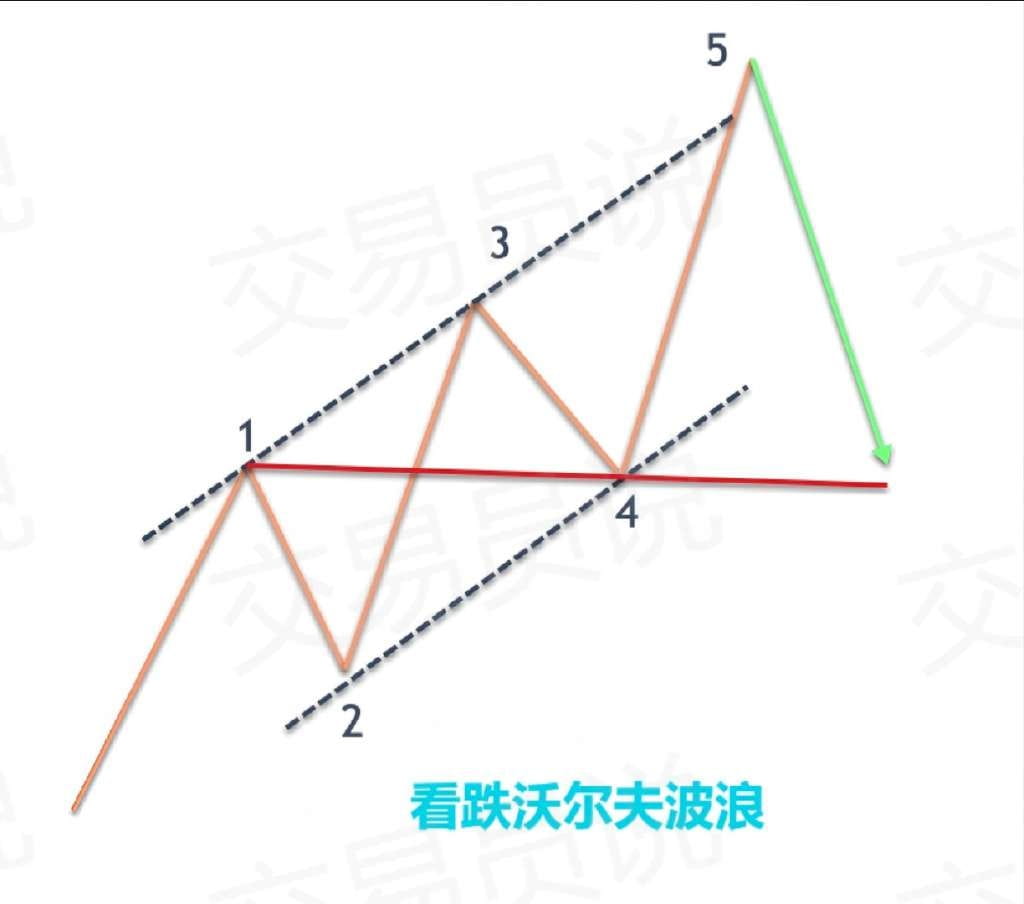
The bearish Wolfe Wave pattern starts with an upward first wave. Then, the second wave appears and drops, with the resulting swing low above the starting point of the first wave. Next, the third wave starts to rise, and its endpoint is higher than that of the first wave. Then is the fourth wave, which moves downward in the opposite direction of the third wave, and its endpoint is higher than the swing low of the second wave.
At this stage, a trend line needs to be drawn connecting the end of the first wave and the end of the third wave. Another trend line connecting the end of the second wave and the end of the fourth wave should also be drawn. These two trend lines should appear roughly parallel. The last wave, the fifth wave, should slightly break above the trend line (especially the 1-3 trend line). This is often seen as a false breakout.
The true sell entry signal appears when the price breaks above the upper trend line and then re-enters the channel. The price is rejected in that upper area and returns to the channel, confirming the validity of the Wolfe Wave pattern.
As you may have noticed, the bearish Wolfe Wave pattern is a counter-trend trading strategy aimed at shorting an uptrend at a high probability reversal point. After entering the bearish Wolfe Wave pattern, the expected target price can also be calculated.
To calculate this expected price movement, a trend line connecting the end of the first wave and the end of the fourth wave needs to be drawn and projected forward. When the price movement approaches this 1-4 trend line, we can expect the price to find support there again.
Wolfe Wave trading strategy.
Now let’s construct a complete trading strategy based on the Wolfe Wave pattern. This will be a strategy purely based on price action, meaning we will not use any other technical indicators or oscillators but focus on the price structure forming the Wolfe Wave pattern.
Bullish entry rules for trades.
⊙ We need to confirm that the price is in a downward trend.
⊙ Once a potential bullish Wolfe Wave pattern is identified, each segment of the waves within that pattern needs to be marked.
⊙ Draw a line connecting wave 1 and wave 3, and another line connecting wave 2 and wave 4. These two lines should form a relatively parallel price channel.
⊙ Wave 5 should break above the 1-3 trend line but quickly reverse and return to this parallel channel.
⊙ When a bullish close appears within the channel, it triggers a buy entry signal.
⊙ The stop loss should be set below the swing low of wave 5.
⊙ Draw a trend line connecting wave 1 and wave 4 and extending forward, which will serve as a target point. When the future price touches this target line, close the position.
Bearish entry rules for trades.
⊙ We need to confirm that the price is in an upward trend.
⊙ Once a potential bearish Wolfe Wave pattern is identified, each segment of waves within that pattern needs to be marked.
⊙ Draw a line connecting wave 1 and wave 3, and another line connecting wave 2 and wave 4. These two lines should form a relatively parallel price channel.
⊙ Wave 5 should break the 1-3 trend line but quickly reverse and return to this parallel channel.
⊙ When a bearish close appears within the channel, it triggers a sell entry signal.
⊙ The stop loss should be set above the swing high of wave 5.
⊙ A trend line connecting wave 1 and wave 4 and extending forward will serve as a target point. When the future price reaches this target line, close the position.
Example of a bullish Wolfe Wave strategy.
Next, let’s look at a price chart to illustrate the Wolfe Wave trading system outlined in the previous section. In the price chart below, you will see a Wolfe Wave pattern from the entire year’s market. Specifically, this example shows a bullish Wolfe Wave setup for the USD/CAD currency pair (USDCAD) in the 240-minute time frame.
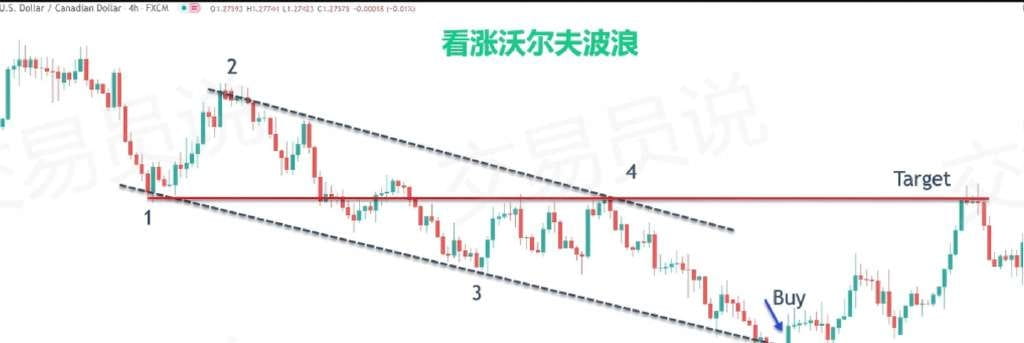
Now let’s analyze this potential bullish Wolfe Wave pattern step by step and see how to trade it according to the rules we set earlier. First and foremost, we must ensure that the price of USDCAD is in a downward trend. From the price chart, this is evident. As the downward trend progresses, we will identify a potential bullish Wolfe Wave pattern forming at some stage.
We will number each segment in the structure starting from the first wave. When the price enters the early stage of the fifth wave, we can draw two trend lines.
The first line is the 1-3 trend line, connecting the swing lows of the first wave and the third wave.
In addition, we will draw the second trend line connecting the swing highs of the second and fourth waves. After completing this step, we will check these two trend lines to confirm that they are roughly parallel.
In the later stages of the fifth wave, we can see that the price breaks below the 1-3 trend line but is quickly blocked and rebounds, returning to the price channel. Notice the first green candlestick in the channel—it is our entry signal for going long on the USDCAD currency pair.
Upon execution of the buy order and establishing a long position, we will immediately set a stop loss to prevent any adverse price movements. The stop loss will be set below the swing low of the fifth wave, marked in the chart as the orange line labeled 'Stop'.
Next, we need to mark this trade's potential closing points. Remember, to do this, we will draw a trend line connecting the end of the first wave and the end of the fourth wave and project it forward. This has been illustrated in the price chart with a deep red line.
Note how the price enters this target area, slightly breaks upward, then meets resistance and falls back. Fortunately, we will close the position at an ideal time and gain considerable profit.
Example of a bearish Wolfe Wave strategy.
Now let's look at an example of the second Wolfe Wave strategy. This time, we will focus on a bearish Wolfe Wave structure. Below is a price chart of the USDJPY currency pair in the 240-minute time frame.
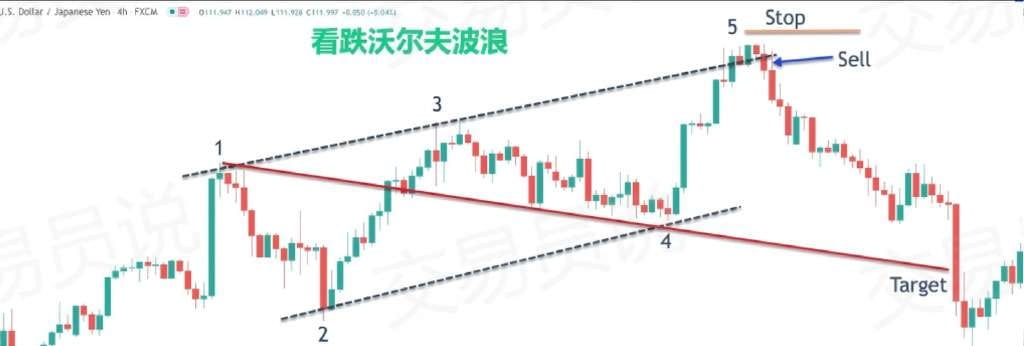
Starting from the very left of the price chart, we can see the price movement is rising, thus meeting the initial conditions of the bearish Wolfe Wave strategy. As the price continues to rise, we can see a 'stair-step' price movement forming waves 1 to 5.
More specifically, we can see that the first and third waves rise along the overall trend direction, while the second and fourth waves are counter-trend pullbacks, each retracing part of the first and third waves. As the price continues to rise in the early stages of the fifth wave, we can identify that a potential bearish Wolfe pattern is developing.
Next, we will draw a trend line connecting the swing lows of the second and fourth waves to form the lower boundary of the parallel channel. At the same time, we will draw another trend line connecting the swing highs of the first and third waves to form the upper boundary of the parallel channel.
At this step, we will wait to see if the price movement of the fifth wave will break the 1-3 trend line, providing us with a potential short opportunity. As shown in the figure, the fifth wave did break the 1-3 trend line and began to consolidate in that area. But soon the price was rejected downwards, confirming the establishment of the bearish Wolfe Wave pattern.
Next, we will use a market order to short the USDJPY currency pair when the price first moves downward back into the parallel price channel. The position marked 'Sell' with a blue arrow in the chart indicates this position. After our short order is triggered in the market, we need to focus on setting the stop loss.
According to our rules, the stop loss should be set above the swing high of the fifth wave. The target for closing the trade is estimated through the 1-4 trend line. We will connect the swing high of the first wave with the swing low of the fourth wave and project this trend line forward. Note how the price enters this target area before reversing upward again.
Summary.
The Wolfe Wave structure is a lesser-known chart pattern, but when used correctly, it is a very powerful pattern. The Wolfe Wave pattern appears in many different markets, including stocks, futures, and forex markets. It can also be observed across various time frames.
That said, the most ideal and reliable trading opportunities for the Wolfe Wave pattern usually occur on time frames of four hours and above. Technical analysts should focus on these periods when looking for high-probability Wolfe Wave patterns. Traders can either manually search for these patterns on the price charts or use Wolfe Wave indicators to assist in identification.
It is worth mentioning that this pattern is often confused with the Elliott Wave impulse structure. Although there are some similarities between the Wolfe Wave structure and the Elliott Wave impulse structure, there are also very clear differences. While this article does not compare and analyze the differences in detail, it is a serious topic that serious chart analysts should research deeply themselves.

6 Golden Rules for Survival in the Crypto Market: Lessons Learned After 5 Liquidations!
Brothers, stop asking 'how to make money in the crypto market'; first, understand 'how to survive'. I understood this only after five liquidations: it’s not about who makes money fast in the crypto market; it’s about who can survive the longest. Master these 6 survival systems, and even with average skills, you can endure until the market turns.
1. Capital management: 1% risk rule locks the bottom line.
The risk of a single trade must not exceed 1% of the capital; this is the iron rule for survival.
Algorithm: With a capital of 100,000, the maximum loss per trade is 1,000 yuan. Reverse calculate the position size (for example, BTC contracts with a 3% stop loss and 10x leverage can only open a position of 3,333 yuan each time).
Split positions: 5 parts of capital, 3 parts for trend trades, 2 parts for swing trades. If a trend trade loses 1 part, stop; if a swing trade loses twice in a row, pause. A student used this strategy with 50,000 as capital and earned 20,000 in a year, with a maximum drawdown of only 8%.
2. Dual stop loss insurance: Technical + Capital stop-loss mechanism.
Technical stop loss: For trend trades, look at the 4-hour MA20; cut it if it falls below; for swing trades, use 2×ATR (e.g., ATR500, stop loss 1000).
Capital Stop Loss: Cut losses immediately if they reach 1% of total capital, regardless of technical analysis.
Strong measure: Use conditional orders to set stop losses in advance; set them as soon as you place an order so that the system can manage your hand.
3. Dynamic position balance: Keep 30% cash in both bull and bear markets.
Bull market position = (current price ÷ historical peak price) × 100% (e.g., BTC 50,000 ÷ previous high 69,000 ≈ 72% position).
Bear market position = (historical low ÷ current price) × 30% (e.g., BTC 30,000 ÷ historical low 15,000 × 30% = 15% position).
Adjustment Signal: Weekly MACD golden cross increases 10% and adds 10% position, death cross drops 10% and reduces 10% position; mechanical operation avoids emotions.
4. Market filtering: 90% of the market should be given up.
Only act when there is a three-cycle resonance.
Only go long when the weekly MA5 is above MA20; conversely, go short; remain in cash during sideways movements.
Trading volume must increase by more than 1.5 times; otherwise, it is a false market.
Only enter positions at the beginning or middle of bull market months, or at the end of bear market quarters; avoid trading in the 3 days before and after expiration.
5. Emotional management: Mechanical execution replaces the brain.
Turn trading into a production line, standardize decision-making with an execution table.
Enforce a mandatory close at 30% profit and cut positions immediately at a 1% loss.
Violating once results in a 24-hour trading halt, using rules to combat human weaknesses.
6. Uncommon survival techniques in a bear market.
Switch holdings: Convert 80% of altcoins to BTC; they drop the least and rebound the fastest.
Options insurance: Buy call options using 1% of capital for every 20% drop; in January 2023, a $5,000 option at $16,000 earned $30,000.
Reduce frequency: Trade once a month to save 80% on fees.
Conclusion: The ultimate key to survival is to acknowledge the ordinary. I rely on simple methods—strictly manage capital, mechanically execute trades, and keep 90% of the time in cash; my account steadily grows every year. The rules of the crypto market are not about offense but defense; survive until the bull market, and a 20% annual compound return is a winner.
Survival dashboard: Daily three questions—Did the drawdown exceed 5%? Did weekly trades exceed 3 times? Did I violate the execution table? Must meet all standards to qualify.
How many people have lost hope due to fluctuations, but managed to stabilize their footing or even turn things around using this system? Countless— but there's one core principle: dare to follow, dare to act, and don't drag your feet.
In the crypto market, making one million requires either a big bull market and holding on, or betting on a coin that skyrockets, or using high leverage to bet in the right direction. But most people lose money, so don't just look at wealth stories; first, think clearly about how much risk you can bear.
If you are also a technical enthusiast in the crypto market, click on the coin homepage.
Click on the avatar to follow me for first-hand news and in-depth analysis!